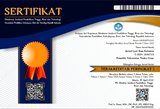Distribusi Spasial Kualitas Perairan Pantai Pasir Mayang Kabupaten Kayong Utara Provinsi Kalimantan Barat
Abstract
activity to carry out, especially in coastal waters which are very
easily contaminated and prone to pollution. The waters of Pasir
Mayang Beach are influenced by inputs from rivers and the
activities of coastal communities, which in turn affect the water
quality and aquatic organisms. The purpose of this study was to
determine the condition of water quality using seawater quality
standards and map them spatially. Water quality parameters
surveyed included temperature, salinity, pH, oxygen level and
brightness which were measured at 17 survey locations. The
survey method used was direct data measurement and the data
was grouped into tabular form using Ms. Excel 2010 and the
results were compared and matched with seawater quality
standards stipulated by the Minister of Environment Regulation
No. 51 of 2004. Spatial distribution was carried out using ArcGIS
10.4 software and interpolated using the inverse distance
weighting (IDW) method. Measurement and analysis results were
obtained for temperature parameters between 30-31.6 °C.
Salinity 11.3 to 21.7 ‰. pH 7.0-7.9;DO 2.1-3.6mg/L. Based on
the research results, the following conclusions can be drawn:
Some of the seawater quality of Pasir Mayang Beach still meets
the established quality standards, including temperature and pH,
so that it can be further classified according to its function.
However, there are several parameters that do not meet quality
standards, namely: Salinity, DO and Clarity. For theeDO
parameter, thereeareeseverallresearchhstationssthat are still
within or below the quality standard.
Full Text:
PDFReferences
Dahuri, R., & Arumsyah. (1994). Ekosistem
Pesisir. In Makalah pada Marine and
Management. Kupang: PSL-UDANA.
Effendi, H. (2003). Telaah Kualitas Air: Bagi
Pengelolaan Sumberdaya dan Lingkungan
Perairan. Yogyakarta, Indonesia: Kanisius
Gemilang, W.A., dan Kusumah, G. 2017. Status
indeks pencemaran perairan kawasan
mangrove berdasarkan penilaian fisika-
kimia di pesisir Kecamatan Brebes Jawa
Tengah. EnviroScienteae, 13(2), 171-180
Hutabarat, S., dan Evans, S.M. 1984. Pengantar
Oseanografi. Jakarta: Universitas Indonesia
Press
Keputusan Menteri Lingkungan Hidup No. 51
Tahun 2004.Tentang Baku Mutu Air Laut.
Kadim, M.., Pasisingi, N., & Paramata, A. R.
(2017). Kajian kualitas perairan Teluk
Gorontalo dengan menggunakan metode
STORET. Jurnal Depik, 6(3), 235–241
Megawati, C., Yusuf, M., dan Maslukah, L. 2014.
Sebaran kualitas perairan ditinjau dari zat
hara, oksigen terlarut dan pH di perairan
selatan Bali Bagian Selatan. Jurnal
Oseanografi, 3(2), 142-150
Nontji, A. 2005. Laut Nusantara. Jakarta:
Penerbit Djambatan.
Palaniappan, M., P.H. Gleick, L. Allen, M.J.
Cohen, J.C. Smith. & Smith, C. (2010).
Clearing The Waters: A focus on water
quality solutions. Nairobi, Kenya: United
Nation Environtment Programme &
Pacific Institute.
Salmin. (2005). Oksigen terlarut (DO) dan
kebutuhan oksigen biologi (BOD) sebagai
salah satu indikator untuk menentukan
kualitas perairan. Jurnal Oseana, 30(3), 21–
Simanjuntak, M. 2009. Hubungan faktor
lingkungan kimia, fisika terhadap distribusi
plankton di perairan Belitung Timur,
Bangka Belitung. Journal of Fisheries
Sciences, 11(1), 31-45
Widiadmoko, W. 2013. Pemantauan Kualitas Air
Secara Fisika dan Kimia di Perairan Teluk
Hurun. Bandar Lampung: Balai Besar
Pengembangan Budidaya Laut (BBPBL)
Lampung
DOI: https://doi.org/10.35308/jlik.v%25vi%25i.8047
Refbacks
- There are currently no refbacks.
Copyright (c) 2023 Robin Saputra
Jurnal Laot Ilmu Kelautan
e-ISSN: 2684-7051 I DOI: 10.35308
Jl. Alue Peunyareng, Ujong Tanoh Darat, Meureubo, Kabupaten Aceh Barat, Aceh 23681, Indonesia
(0655) 7110535 l l +6282268863033
 is licensed under a Creative Commons Attribution-ShareAlike 4.0 International License
is licensed under a Creative Commons Attribution-ShareAlike 4.0 International License













